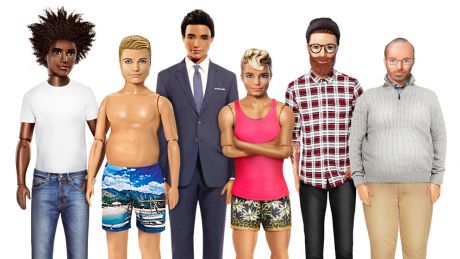No, We Don’t Need a Dadbod Ken
It’s great news that Barbie’s getting a makeover - but if anything, we should all aspire to look a bit more like Ken

So, Barbie is getting (slightly) more realistic. Mattel has reacted to declining sales – and increasing numbers of people pointing out that its most famous creation’s neck would have difficulty supporting her head – and revealed the upcoming release of Curvy, Tall and Petite editions of the iconic doll, alongside versions with different skin tones and hair.
It’s difficult to argue that this is a bad thing, so most people haven’t bothered. Instead, the internet’s laser-guided sense of justice and fair play has turned on the most obvious target possible: Ken Carson. “What about a dadbod Ken?” bleated Twitter’s least original comedians within milliseconds of Mattel’s announcement. “Why can’t I, a grown man, have a toy that represents my own body shape? Surely he’s setting unrealistic body image standards for men, too?”
Well, firstly, no he isn’t, or at least not to nearly the same extent. The average woman’s waist-to-hip ratio, for instance, is 0.8 – Barbie’s is 0.56, or not quite big enough to fit in an entire liver. According to a University Of South Australia study, you can expect to find Barbie’s proportions “naturally” in 1 in 100,000 woman: Ken’s is found in 1 in 50 men.
An estimated 6.4% of the UK population suffer from some form of eating disorder: 75% of them are women. Yes, some men suffer from forms of body dysmorphia, but not to nearly the same extent: you might have seen the “10% of gym-goers have bigorexia” stat bandied about, but that’s based on a very small study done on very serious bodybuilders 30 years ago.
But there’s something more important going on here. Ken is actually in pretty aspirational shape. For almost any woman on the planet to look proportionally more like Barbie, they would need a starvation diet, cosmetic surgery and neck-lengthening tips from the Kayan people of Myanmar.
Looking like Ken, for most men, would mean drinking less beer and doing the occasional pull-up. Ken isn’t exactly King Leonidas, or He-Man, or Lion-O, but even if he was, then chasing after his body shape would probably make most men more healthy, not less. Which isn’t something you can say about Barbie.
I think we can all agree that dadbods are hilarious – thank you, Jason Segel – but slightly less guffaw-worthy are the chunky deposits of visceral fat they signify, since that’s the dangerous type that seriously ups your chances of diabetes, cancer, dementia and stroke.
Get the Coach Newsletter
Sign up for workout ideas, training advice, reviews of the latest gear and more.
Ken hasn’t got a chiselled six-pack – he’s just got the faint outline of abs that signifies an entirely healthy body fat of 12% or so. He’s a bit muscular, but that’s a good thing: it probably means that he’s doing the sort of resistance training that’s been shown to stave off osteoporosis and Alzheimer’s, unlike his twig-armed girlfriend.
So please, no more clamouring for a dadbod Ken. It’s obvious and unfunny, but more importantly it undermines a problem that, for young girls, is actually serious. We’ve had it incredibly easy for an incredibly long time, and whining that we aren’t being treated fairly when the pendulum swings ever-so-slightly away from our favour is just undignified. By all means, rail against the expectation that you should have facials or obsess about the right shoes or Botox your face, but don’t ask Ken to let himself go just so you can feel a bit better about yourself, even for a laugh. After all, we could all do with looking a bit more like him.
Image by @jamiephillipstv for Lyst
From 2008 to 2018, Joel worked for Men's Fitness, which predated, and then shared a website with, Coach. Though he spent years running the hills of Bath, he’s since ditched his trainers for a succession of Converse high-tops, since they’re better suited to his love of pulling vans, lifting cars, and hefting logs in a succession of strongman competitions.

